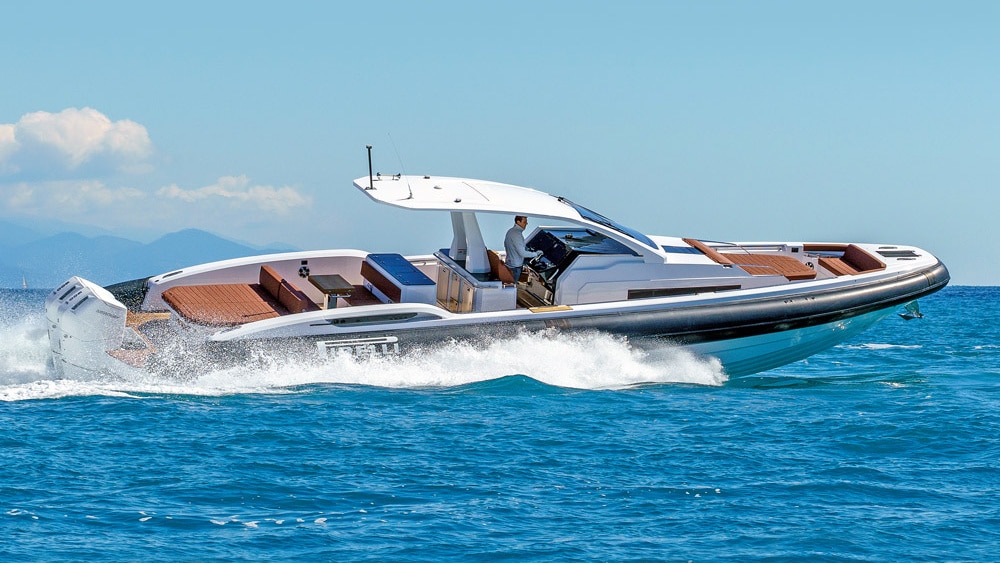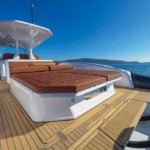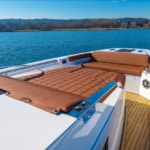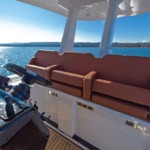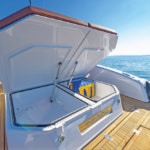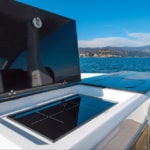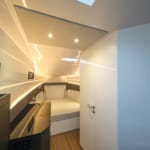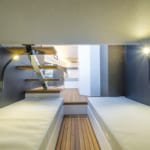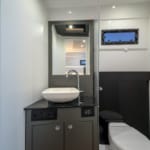TMS flies out to Genoa, Italy, to test a double European first, namely Pirelli’s latest Mannerfelt designed flagship 50 maxi-RIB coupled with a brace of Mercury 600hp V12 outboards, and concludes that sometimes, it would appear, size really is everything …
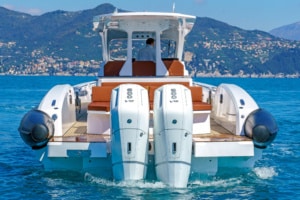
V12 – This first Pirelli 50 off the production line is powered by a brace of Mercury Marine’s latest and biggest outboards, namely the positively giant 7.5L V12 Mercury Verado, which affords, thanks to its twin-engine set-up, a mighty 1200hp.
When PBR received the invitation from Mercury Marine to fly out as their guests to Italy to test and sea-trial a three-star line-up of mega-RIBs rigged with Mercury’s flagship V12 outboards, we jumped at the chance. Not only did it provide us with one of the very first opportunities in Europe to test these engines in a twin-rig setting, but the added bonus was our being able to get behind the wheel of the brand-new Ted and Ocke Mannerfelt-designed Pirelli 50, the latest flagship model of the newly merged Sacs TecnoRib company’s line of ‘walk-arounds’ (a series of RIB models this premier Italian brand launched in 2020).
As Gianni De Bonis, CEO of Sacs TecnoRib, revealed to us: ‘Our flagship Pirelli 50 represents the culmination of a journey that has seen the creation of three models in just three years. This model is evidence of our determination to underpin and strengthen our company’s continuing success even further, both within our home market and abroad.’
Come the day of the test, I was welcomed at the dock by an imposing group of Mercury PR agents, as well as representatives from the Sacs TecnoRib factory and De Bonis himself. Everyone was clearly very proud of the boats on parade, particularly the 50, of course. But before I describe what it’s like to drive the 1200hp Pirelli 50, allow me to take you on a tour of this extraordinary vessel in order to give you some insight into its making and fit-out.
The Mannerfelt factor
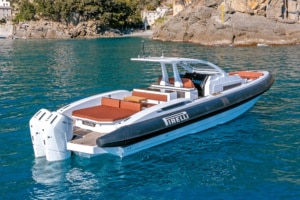 This Pirelli 50, which combines the raw performance of a maxi-RIB with the high-end hospitality of a motor yacht, followed the launch of the Pirelli 42, presented at the beginning of 2020, and then the subsequent launch of the Pirelli 35. All three ‘walk-arounds’ have been so successful that, as a consequence of the record number of requests for the first two models, even before the official presentation of the Pirelli 50, TecnoRib already had all of their 2022 production and part of next year’s build slots allocated.
This Pirelli 50, which combines the raw performance of a maxi-RIB with the high-end hospitality of a motor yacht, followed the launch of the Pirelli 42, presented at the beginning of 2020, and then the subsequent launch of the Pirelli 35. All three ‘walk-arounds’ have been so successful that, as a consequence of the record number of requests for the first two models, even before the official presentation of the Pirelli 50, TecnoRib already had all of their 2022 production and part of next year’s build slots allocated.
Perhaps unlike some of its maxi-RIB peers, the new Pirelli 50 is a highly versatile craft, one perfectly capable of fulfilling the role of cruiser, offshore adventure craft or even a support/chase craft to a superyacht.
The 50’s aerodynamic and contemporary appearance reflects the attributes of the other models in the triple-boat range. This, of course, is due largely to all these craft being the product of the same draughtsman’s work, namely the collaborating design skills of the world-famous Mannerfelt Design Team. The Mannerfelts have made an enormous contribution to this particular RIB brand’s renowned performance and offshore capabilities. For those who may not be aware, Ted Mannerfelt, son of Ocke, raced powerboats as a youngster and then went on to be an automotive design engineer at both Jaguar Land Rover and Lotus. Ted’s speciality involves all the intricate design work relating to the topsides of the Pirelli range, while his father, Ocke, is the man responsible for everything below the waterline. Like its stablemates, the 50’s distinctive, twin-step hull delivers a driver’s dream, which is hardly surprising, perhaps, when you consider Mannerfelt senior’s illustrious international powerboat racing career.
Talking design, this father and son team take their inspiration from nature. When driving one of his ‘bat boats’, Ocke told me he was inspired by the kingfisher. In the case of the 50, the duo wanted the boat to look fast even when stationary. The taut lines of the tubular structures and the clean lines of the helm and topsides are softened by the sporty hardtop and the aft section mouldings, which help to create even greater sleekness.
Above and within
The external layout of the Pirelli 50 features a single-section, central moulding that also incorporates the bow sundeck, which leaves a clear passageway forward. The entire walkway is protected by substantial GRP gunwales and is served by two long handrails, discreetly positioned so as not to impair the external lines of the craft. Additionally, there are numerous comfortable handholds, both alongside the solarium and within the profiles of the vessel’s sides. Thanks to the vessel’s internal configuration, one feels very much ‘within’ the craft, which adds to the sense of on-board security and will surely represent a big plus for families with children.
The large, comfortable aft sundeck features a moveable backrest to serve both the sundeck and the dining area. Behind this area you’re then greeted by a dinette, whereupon a teak table, extendable on both sides, allows crew and guests to dine in comfort, again with enough space for all the family. The bar/kitchen area, covered by the continuation of the hardtop, comes fitted with a sink, a hob with two induction burners, and not one, but three refrigerators and ice makers!
- The large, comfortable aft sundeck features a moveable backrest to serve both the sundeck and the dining area.
- Lush bow sundeck and seating.
- The black, luxuriously comfortable and ergonomically sound helm station has three seats, with folding elements that allow one to select the most suitable seating option.
- The design layout includes a multitude of lockers and dry housings both fore and aft.
- The bar/kitchen area, covered by the continuation of the hardtop, comes fitted with a sink, a hob with two induction burners, and not one, but three refrigerators and ice makers!
The black, luxuriously comfortable and ergonomically sound helm station has three seats, with folding elements that allow one to select the most suitable seating option. This whole area has been designed in a raised position in relation to the rest of the deck to increase visibility. However, for the passenger in the far port seat, their legs will be left dangling when in the seated/non-lean-to position, in contrast to the helm and navigator’s positions, which have the benefit of a footrest moulding.
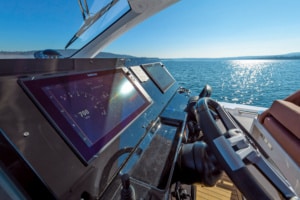
The design of the flight deck is impressive and provides the driver and navigator with a commanding position with all the latest display technology arrayed before them to both inform and enhance every aspect of the helming experience. Unobstructed, all-round visibility from the cockpit is another plus factor. With the aid of the Mercury joystick control, close-quarter manoeuvring especially is simplified hugely, to the point where we found it perfectly feasible to ‘captain’ this vessel single-handedly. In particular, the Mercury ‘Skyhook’ system is an ingenious aid to holding station while fenders and lines are being made ready.
Perhaps not surprisingly aboard a vessel of this size and type, the design layout includes a multitude of lockers and dry housings both fore and aft, which combined afford vast amounts of stowage for kit and for toys. Access to the lower cabin is good, and the first impression of going down below is one of space and contemporary interior design. The test craft features two double cabins, one with a double bed up in the bow and the other with twin beds in the stern. Both cabins have plenty of deep wardrobes and large amounts of storage. I should point out, though, that the twin beds aft, located under the helm, are in plain view of the forward double berth. This means little or no privacy for hosts and guests, and therefore it’s my view that this present configuration lends itself more to a family with young children. The galley, heads and both cabins are all well lit thanks to a good degree of natural light via the portholes and the use of light fabrics. Discreet LED lighting completes the ambience.
- Main double cabin at the bow exudes a feeling of space and contemporary design.
- Twin cabin. Both the cabins have plenty of deep wardrobes and large amounts of storage.
- Modern and stylish heads.
How relevant?
If you had asked me upon its launch last year what I thought of the new V12 600hp offering from Mercury Marine, I would have answered with some caution and possibly even a little scepticism. That may seem at odds with my passion for, and history with, big performance outboards, and upon an initial review of the V12’s technical data you might have even drawn the same conclusion. I mean, the power-to-weight ratio doesn’t come close to the lighter, more agile Mercury 450R and the latter’s ability to ‘rocket-ship’ virtually every transom it blesses. Nevertheless, delve a little deeper into the attributes of the V12 600hp and things start to change perspective. Get behind the wheel of a craft boasting two or more of these machines, as I did at the Miami Boat Show this year, and I think, like me, you won’t fail to become a ‘believer’, because it’s clear, for many, that the Mercury V12 600hp is the answer to a prayer.
This first Pirelli 50 off the production line is powered by a brace of Mercury Marine’s latest and biggest outboards, namely the positively giant 7.5L V12 Mercury Verado, which affords, thanks to its twin-engine set-up, a mighty 1200hp. These motors are equipped with a two-speed PowerShift transmission and steerable gearcase, while the upper unit stays fixed to the transom. This creates a very clean look aft, with steering and rigging both being integrated into the unit itself.
White knuckles and white horses
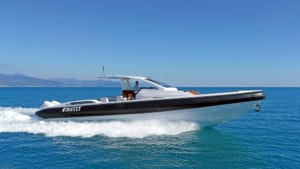 On the day of our PBR test, the wind was blowing a sprightly Beaufort force 6 and the Italian team were becoming noticeably ‘protective’ of their new craft. However, politely ignoring their nervous twitchings, it was my aim to see exactly what this 800,000 euros worth of waterborne projectile had to offer, through fair or foul!
On the day of our PBR test, the wind was blowing a sprightly Beaufort force 6 and the Italian team were becoming noticeably ‘protective’ of their new craft. However, politely ignoring their nervous twitchings, it was my aim to see exactly what this 800,000 euros worth of waterborne projectile had to offer, through fair or foul!
The 1200hp engines create so much torque, developing power in such a linear way, that contrary to my earlier fears, to my delight it took no time at all to discover that the V12 twin rig was, in fact, genuinely sporty to drive. Likewise, because boat and engines are so well matched, I soon forgot that I was driving such a large and substantial vessel. The comparison I would perhaps make would be to a 10–12 m powerboat. Power in abundance was on tap exactly when needed, which made the business of helming the craft at speed through the challenging conditions an absolute pleasure. Indeed, despite their substantial payload, the engines gave no sign of unbalancing the boat whatsoever, even when driving hard into the steep head seas. In fact, the boat appears to literally ‘crush’ the waves.
50 knots, force 6
With everyone checked and secure, I opened up the throttles once more, and then, employing some well-practised race-proven driving techniques, I drove her with the seas on my beam as if Steve Curtis was off my port side and Ocke Mannerfelt himself was on my starboard quarter. We were now charging down the Italian coast, and for the first time I began to appreciate fully what this magnificent combination of these engines and their dynamic steed was truly capable of.
Fifty knots is not inconsequential in the conditions we found ourselves taking in off Genoa that day. The new 50 and her 1200 horse team needed little spurring on through the Mediterranean’s striking panorama of white horses. Indeed, the boat revelled in every opportunity I gave her in these conditions. While ahead of me came the rearing seas, behind me I was relieved to see a line of smiling faces now gracing the back seats!
I would add just one observation, though: when put into a hard turn, the lateral stability of the T-top could do with some more work. This element of the boat’s anatomy tends to vibrate, and shudder if you catch a wave amidships. Thus, some additional support or strength in the central post would help to reduce this, in my view.
Why would you?
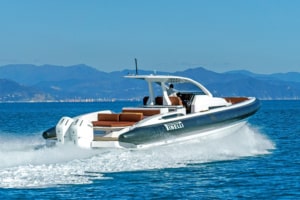 If you are hungry for even more power than these V12s can deliver, it is possible to have the 50 rigged for a maximum of 1800hp. In a world where we need to be more conscious than ever of the impact we make on the oceans, one could question why the Mercury V12 600hp should be the design choice of any boat manufacturer. Well, consider this: craft of this size would traditionally be rigged with inboard diesel engines of 500–700 hp. These for the most part are large-displacement lorry engines, and when running at high RPMs all day long at sea they exude large amounts of carbon emissions. Diesel engines require greater maintenance, and they involve more consumable parts too. They are also more complex to install than their outboard alternatives. In the case of a vessel such as the Pirelli 50, outboards allow for more deck and internal space, which also translates to additional cabining and facilities, as well as the introduction of a Seakeeper stabiliser system – an absolute boon on any craft, in my view. But when you’re talking fuel consumption differences between inboard and outboard, the comparison is interesting, if not enlightening. For example, the combined fuel burn of the twin Mercury 600hp rig at 34 knots/4500rpm constitutes 200 litres an hour. (Bear in mind these figures reflect the fact that the Pirelli 50 is a 13.5-tonne craft, and with 800 litres of fuel and 400 litres of water in its tanks, it’s more like 15 tonnes all up.) But then, if you compare the typical fuel burn of a twin Volvo D9 575hp inboard engine set-up within a Princess V50 running at 34/35 knots, according to our records, you’d be burning 212 litres an hour. When comparing the two options, then, the difference between diesel and petrol can be marginal at cruising speeds.
If you are hungry for even more power than these V12s can deliver, it is possible to have the 50 rigged for a maximum of 1800hp. In a world where we need to be more conscious than ever of the impact we make on the oceans, one could question why the Mercury V12 600hp should be the design choice of any boat manufacturer. Well, consider this: craft of this size would traditionally be rigged with inboard diesel engines of 500–700 hp. These for the most part are large-displacement lorry engines, and when running at high RPMs all day long at sea they exude large amounts of carbon emissions. Diesel engines require greater maintenance, and they involve more consumable parts too. They are also more complex to install than their outboard alternatives. In the case of a vessel such as the Pirelli 50, outboards allow for more deck and internal space, which also translates to additional cabining and facilities, as well as the introduction of a Seakeeper stabiliser system – an absolute boon on any craft, in my view. But when you’re talking fuel consumption differences between inboard and outboard, the comparison is interesting, if not enlightening. For example, the combined fuel burn of the twin Mercury 600hp rig at 34 knots/4500rpm constitutes 200 litres an hour. (Bear in mind these figures reflect the fact that the Pirelli 50 is a 13.5-tonne craft, and with 800 litres of fuel and 400 litres of water in its tanks, it’s more like 15 tonnes all up.) But then, if you compare the typical fuel burn of a twin Volvo D9 575hp inboard engine set-up within a Princess V50 running at 34/35 knots, according to our records, you’d be burning 212 litres an hour. When comparing the two options, then, the difference between diesel and petrol can be marginal at cruising speeds.
Fuelling costs and the availability of dockside petrol will have a bearing on the market, of course, however it’s quite clear that in many territories around the world there is most certainly a place for the Mercury 600hp, and when coupled to a Pirelli 50, the pairing makes for a dynamic allying of power and hydrodynamic superiority.
Performance
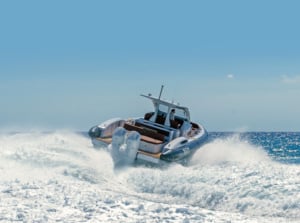 Mercury Verado V12 600
Mercury Verado V12 600- No. of engines: 2
- Cylinders: 12
- Gear ratio: 2.48
- Propeller: Verado V12 27.5in
- Mounting height: 1
Specifications
- Length overall: 15.2m
- Overall width: 4.7m
- Tubes: ORCA 866
- Hull: Stepped
- Fuel tank capacity: 1600L
- Water capacity: 400L
- No. of passengers: 14
- Beds:
- CE category: B
- Designer: Mannerfelt design team

